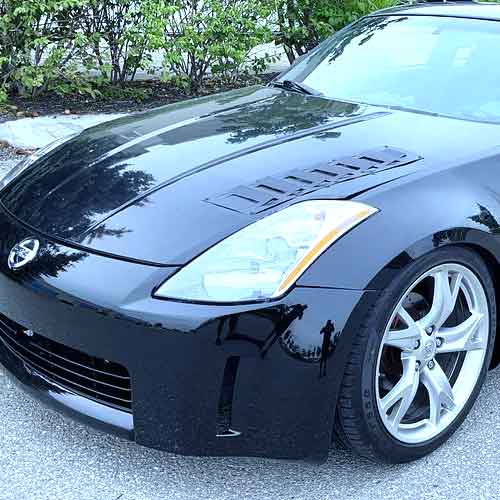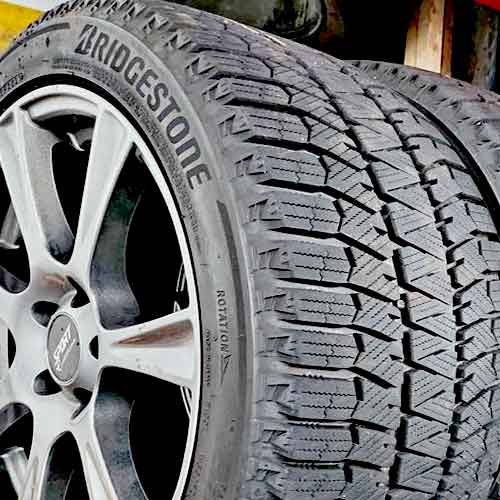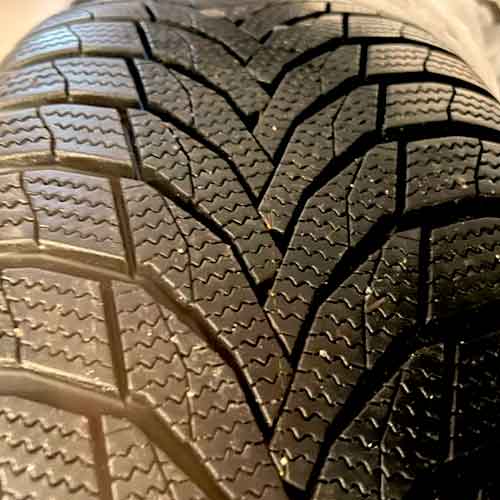Cold weather showdown begins as the Nexen WinGuard Sport 2, with its innovative sipe design for superior traction, confronts the Bridgestone Blizzak WS90, revered for its low-temperature flexibility. Let’s see which tire takes the cake in all of my tests below.

Table of Contents
Sizes Info
The Nexen WinGuard Sport 2 comes in 15 to 20 inches with following.
- Speed ratings: H and V.
- Load ratings: SL and XL.
- Tread depth: 10.5/32″ on all.
- Weight: 15 to 30 lbs.
- Tread warranty: None.
On the other hand, the Bridgestone Blizzak WS90 offers 52 total sizes in 15 to 19 inches rims. They come with following specs.
- Speed ratings: T or H.
- Load ratings: SL or XL.
- Tread depth: 11 or 12/32″.
- Weight: 17 to 29 lbs.
- Tread warranty: None.
Tread Design
The Blizzak WS90 (review) shines in its class with a sturdy and uniquely designed directional tread pattern.

The tread prominently features three ribs, with the central one being a continuous band.
This main rib is furnished with various wave-like sipes and also features straight, interconnected sipes, flawlessly connected with in-groove notches.
Moreover, the V-shaped cuts on the ribs, aimed towards both sides, also contribute to the tire’s improved traction, along with those notches.
The shoulder lugs demonstrate exceptional design, featuring notches that target the central rib and additional ones on the sides that correspond with thick, angled, longitudinal slits.
Moreover, you also see zigzag slits towards the end there, which can also be categorized as in-groove notches.
Apart form that, you get similar siping pattern as seen on the lugs in the middle.
On the other hand, Nexen WinGuard Sport 2 also features a directional pattern, but its unique as well.

The tire’s central area consists of elongated lug arms with multiple sides.
They get pretty closed up together towards the central most area, and separated by slightly slanted longitudinal slits towards shoulders.
These lugs features numerous wave-like sipes, and rectilinear longitudinal slits, as well as chamfered edges along with sharp sides.
Moving towards shoulders, the lugs here are also elongated, and carry similar tread features like seen on the blocks in the middle, well almost…
These lugs have sharp edges and wave like siping, though they have less overall sides to them, and their edges are not chamfered.
Moreover, the longitudinal slits they form, are also thicker and you can say, curving.
Ice Performance
On icy terrains, the Bridgestone Blizzak WS90 emerging as the victor.
This tire outperforms its counterpart with a notably shorter braking distance and faster acceleration time, (as seen on measured tests, and then averaged).
Blizzak basically comes with a very well engineered design, with biters featuring just the right angles.
The slanted incisions combined with V shaped biters facing both lateral directions, all offer superior gripping abilities on icy surfaces.
Moreover, with tire’s greater flexibility and multi angled sipes, that gripping capability is boosted further.
On the flip side, the missing notches on the smoothed out (edges), of Nexen WinGuard Sport 2, however, falls short in this regard.
Although the tire offer good enough grooves, and ample sipes, they just can’t offer as much biting capability as its counterpart.
So overall the Blizzak WS90 is taking the lead here.
Wet Grip
Tread design and rubber compound are two pivotal factors dictating wet traction. And considering both, the Blizzak WS90 is taking the lead, although both tires features an abundance of siping, all over their treads, aiding their grip.
This advantage is due to the tire’s utilization of both rectilinear and interlocking sipes, which possess superior water absorption capabilities, and which are missing on the Nexen’s tire.
With multi-angled sipes basically, the water is wiped/cleared off in all directions.
So it makes sense why the Nexen WinGuard Sport 2, with its primary reliance on laterally oriented sipes, fails to match the overall traction of the Blizzak WS90, leading to longer wet braking distances and handling times.
Snow Performance
In snowy conditions, the Nexen WinGuard Sport 2 edges ahead due to its particular design features.
The tire possesses wider tread voids and in-groove notches that aid in trapping snow particles.
This design promotes increased traction as the lodged snow provides a superior grip than the rubber tread itself.
Additionally, the tire’s swooping V-shaped lugs excel at displacing thick snow, enhancing forward momentum and contributing to better acceleration times.
In contrast, the Bridgestone Blizzak WS90 presents somewhat limited braking and handling capabilities due to its relatively closed design, with a continuous central rib and narrower in-groove notches.
The tire’s directional tread pattern, lacking the swooping arms like seen on its competitor, limits its efficiency, when it comes to snow paddling.
So the Nexen is better here.
Fuel Economy
Fuel economy is influenced by several factors, including the tire’s adherence to the road surface and its overall tread pattern.
And assessing these aspects reveals both tires feature similar rolling resistance values, hence producing similar MPGs.
Though its because of very different reasons.
The Blizzak WS90 lacks with it’s softer compound, which causes extra lug bending. And since energy is required in to bending/molding the lugs, the overall economy is lowered.
However, with the tire’s longitudinally aligned rib, that fuel economy is equal to what is seen on Nexen’s tire.
The Nexen WinGuard Sport 2 features although features a directional tread pattern with lateral tread voids, lowering fuel economy.
But as it’s lugs are firmly placed as the tire corners, brakes or accelerates, you get similar fuel economy compared to its counterpart.
Dry Traction
Dry performance is two parts, grip, and handling.
Grip is the tire’s ability to roll or brake when moving straight. That’s why it gets measured with braking distances.
And here the Blizzak WS90 comes out with shorter stopping and handling times, thanks to it’s longitudinal central rib which offer a lot more contact with the ground.
On the other side, the Nexen WinGuard Sport 2 may not be so great in gripping, it’s handling is better.
Handling depends on two things, contact form the shoulders and lug bending, and in both cases the Nexen takes the lead.
The tire although weighs close to its counterpart, its lugs stay firm as the tire corners, and this allows for faster overall steering response.
On the other side, the Blizzak WS90 with its relatively softer compound lacks here, and is not able to show up with similar results.
On tests, it a 0.5 seconds slower to its counterpart.
So to summarize, the Nexen comes out better when it comes to dry handling, whereas the Blizzak takes the lead with its shorter braking distances.
Comfort Levels
Comfort levels of a tire are largely influenced by factors such as road noise and vibration absorption capability. And these characteristics can vary significantly, depending on the tire’s construction.
In terms of noise the Nexen Winguard Sport 2 has the overall upper hand.
The tire is relatively quieter because, noise is just air colliding the walls of tread, and with swooping arms, the air particles face a more streamlined channel, where they mostly pass through without impacting.
On the other side, the relatively louder Blizzak WS90 comes out better in the department of bumps absorption ability.
The tire’s thermally adaptive softer rubber compound allows for more effective cushioning of the bumps.
So in case of impact comfort the Bridgestone WS90 takes the lead.
Conclusion
Upon comparing these two formidable winter tires, each demonstrates specific advantages.
The Nexen WinGuard Sport 2 shines in fluffy snow conditions due to its wider tread voids, in-groove notches, and superior snow-clearing V-shaped lugs, but lacks in ice compared to its counterpart.
Moreover, in terms of dry performance it takes the lead in the handling department but again lacks in directional gripping ability.
And yes, the Blizzak WS90 comes out superior in wet conditions.
Both tires are rated as equals when it comes to comfort and fuel economy.